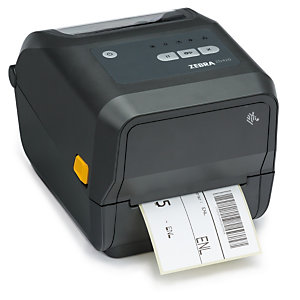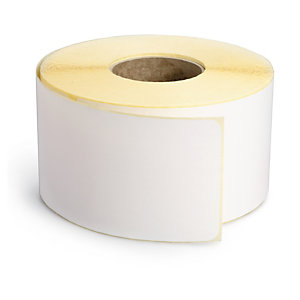► How does a thermal printer work?
Thermal printing uses heat to apply a print to the paper. Thermal printers are used for example for receipts, product labels, shipping labels, etc. There are two types of thermal printing techniques:
| DIRECT THERMAL Printing based on heat alone | THERMAL TRANSFER Printing with ink ribbon |
| Uses paper or labels coated with a special chemical layer. Contact with the heated print head generates a chemical ink reaction which leaves a print. | The heat in the printer melts the ink on the ribbon together with the paper. |
| Printing lasts for a limited period (± 6 months). | Printing lasts indefinitely. |
| For example, for printing receipts. | Used to produce barcode stickers or code products, boxes and pallets. |

Zebra thermal printer – good for webshops.

►What are the benefits of thermal printing?
- Compact smart printers: the printers are small and lightweight and easy to move around. Plus, they take up almost no space on your desk or packing table.
- Easy to maintain: the printers do not require ink or toner cartridges.
- High print capacity: printers can handle many prints per minute and have low power consumption.
- Silent printing: almost silent printing when it is direct thermal printing, where it is ideal for receipts, for example.
A thermal printer is simple to understand and indispensable in the small warehouse when orders are pouring in. It is commonly used when talking retail and EPOS systems for “non-important” documents that may well bear a short life.
What is volumetric weight?
Volumetric weight reflects the density of the package, which is the space a package takes up relative to its actual weight. The volumetric weight is a method many carriers use to find out how much the package takes up in transit and it is usually also the one they bill by if it exceeds the actual weight of the package. It is therefore important to reduce voids and adapt your packaging to the product.
How is the shipping weight calculated?
Shipping weight is the weight you are invoiced and pay for. This can be both the actual weight of your package, but also its volumetric weight, it depends which number is greater.
For domestic and international services, the billable weight is the weight that is greater after comparing volumetric and actual weight. If the volumetric weight of the parcel is greater than its weight, the price is thus determined solely by the volumetric weight of the parcel.
See our range of thermal labels here
If you have any questions, our specialists are available on the chat or by phone on 44 58 77 00.














